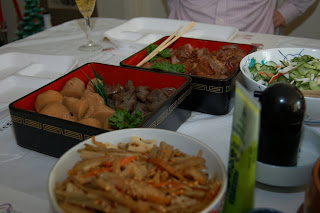




New year’s day is a big holiday for Japanese people. My mom and aunt take turns every year cooking the traditional osechi-ryori. And every year, I say I need to learn how to make it. But of course this year, I failed to come home and wake up early to do so. My mom cooked the meal this year and it was great. Each food has a specific meaning and should be eaten with thought.
Kamaboko: broiled fish paste. Traditionally, slices of red and white kamaboko are alternated in rows or arranged in a pattern. The color and shape are reminiscent of the rising sun and have a celebratory, festive meaning.
Kazunoko: herring roe Kazu means "number" and ko means "child". It symbolizes a wish to be gifted with numerous children in the New Year.
Konbu: seaweed. It is associated with the word yorokobu, meaning "joy".
Kuromame: black soybeans. Mame also means "health," symbolizing a wish for health in the New Year.
Tazukuri: dried sardines cooked in soy sauce. The literal meaning of the kanji in tazukuri is "rice paddy maker", as the fish were used historically to fertilize rice fields. The symbolism is of an abundant harvest.

I am bookmarking this page for my Japa-reference. I never knew ANY of this!!! xoxo. sw.
ReplyDelete